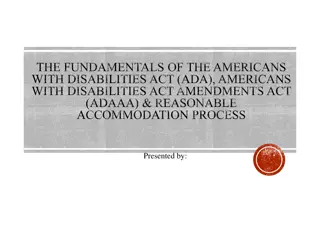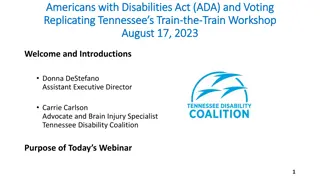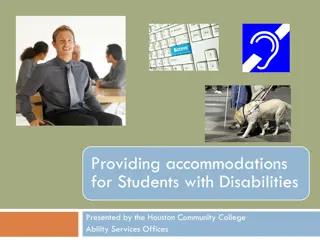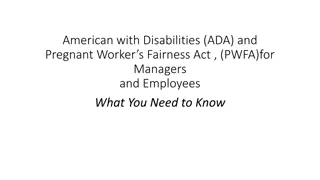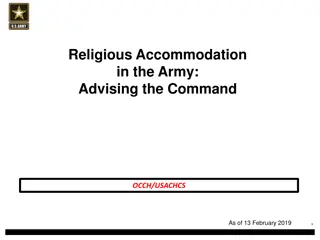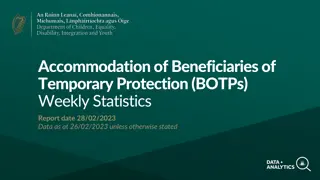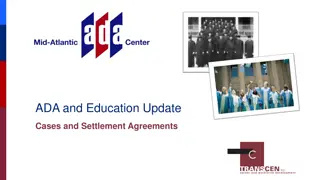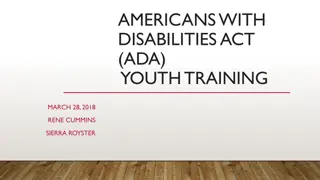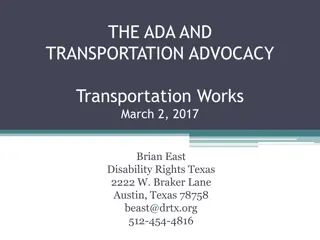ADA and Accommodation Lessons Learned: Stay at Work/Return to Work Edition
Explore the key insights and benefits of Stay-at-Work (SAW) and Return-to-Work (RTW) Programs, relevant laws like the Americans with Disabilities Act (ADA), and the importance of job accommodations in keeping disabled or temporarily impaired workers on the job or facilitating their return to work. Understand the purpose, benefits, and key protections associated with these initiatives.
Download Presentation

Please find below an Image/Link to download the presentation.
The content on the website is provided AS IS for your information and personal use only. It may not be sold, licensed, or shared on other websites without obtaining consent from the author. Download presentation by click this link. If you encounter any issues during the download, it is possible that the publisher has removed the file from their server.
E N D
Presentation Transcript
ADA AND ACCOMMODATION LESSONS LEARNED: STAY AT WORK/RETURN TO WORK EDITION JOB ACCOMMODATION NETWORK (JAN) ACCOMMODATION AND COMPLIANCE WEBCAST SERIES Lisa Mathess, SHRM-CP, Lead Consultant, and Tracie DeFreitas, MS, Principal Consultant JAN is funded by a contract with the Office of Disability Employment Policy, U.S. Department of Labor.
2 HOUSEKEEPING Technical Difficulties https://AskJAN.org/Training/JAN-Webcast-Frequently-Asked-Questions.cfm Q&A option at the bottom of the screen 800-526-7234 or 877-781-9403 (TTY) - or Live Chat at AskJAN.org Frequently Asked Questions (FAQ) https://AskJAN.org/Training/JAN-Webcast-Frequently-Asked- Questions.cfm https://AskJAN.org/Training/JAN-Webcast-Frequently-Asked-Questions.cfm Questions for Presenters Q&A option at the bottom of the screen
3 HOUSEKEEPING 2 PPT Slides Click the link included in the webcast login email you received Captioning Use the closed caption (CC) option or StreamText link shared in the webcast chat Transcript will be available with webcast archive
4 DISCUSSION TOPICS Purpose and Benefits of Stay-at-Work (SAW) and Return-to-Work (RTW) Programs Overview of Relevant Laws ADA and Accommodation Lessons Learned
5 PURPOSE OF SAW AND RTW PROGRAMS SAW: To keep an injured, disabled, or temporarily impaired worker on the job, if medically feasible RTW: To return an injured, disabled, or temporarily impaired worker to the workplace as soon as medically feasible
6 SAW PROGRAM BENEFITS Reduce number of lost workdays Maintain workforce productivity Lower risk of condition becoming long-term or permanent disability Reduce costs
7 RTW PROGRAM BENEFITS Retain valued employees Enhance workforce productivity Save on recruiting/training costs Reduce costs
8 KEY PROTECTIONS There are 3 key protections for employees that employers need to think about when analyzing SAW/RTW initiatives: Americans with Disabilities Act (ADA), as amended Family and Medical Leave Act (FMLA) Workers Compensation (WC) Determine what laws may be in play One or more of these may need to be considered in some cases, all three
9 OVERVIEW OF ADA AND FMLA ADA Employers with 15 or more employees Disability as defined by ADA; can perform essential functions of job with or without a reasonable accommodation Unpaid leave as reasonable accommodation for term needed, if not undue hardship FMLA Employers with 50 or more employees/1250+ hours and 1 year of service Serious health condition as defined by FMLA Up to 12 weeks of unpaid leave; can be intermittent
10 OVERVIEW OF WC AND OTHER PROTECTIONS WC Employer of any size, even small (state-specific) Injury arising out of or in the course of employment, with some exceptions Leave based on nature of injury and medical opinion through workers compensation process Other Protections State civil rights/human rights laws State disability benefits programs Wage and Hour laws
11 OCCUPATIONAL INJURY, DISABILITY, AND/OR SERIOUS HEALTH CONDITION WC Occupational injury or illness ADA Definition of Disability Has/had a physical or mental impairment that substantially limits/limited one or more major life activities FMLA Serious Health Condition Requires hospitalization Incapacitates for more than 3 consecutive days with ongoing medical treatment Chronic conditions that flare and cause incapacitation Pregnancy
12 SAW/RTW LESSONS LEARNED TRAINING STRATEGY Follow a path that leads to a positive employment outcome Note SAW/RTW wrong turns Offer lessons and practical guidance to stay on track
13 WRONG TURNS: SAW/RTW AND THE INTERACTIVE PROCESS Failing to engage in IP/recognize need for accommodation Dismissing temporary injuries/impairments Applying a 100% healed policy
14 LESSON 1: FOLLOW ADA PATH TO ADDRESS SAW/RTW ISSUES Worker need not say reasonable accommodation when requesting help Assume worker likely qualifies under ADA Avoid immediately rejecting request for accommodation Engage in interactive dialogue about reasonable accommodation Ask for details on how individual s proposal would work Try to respond with a reasonable alternative Try to get buy-in from individual Document all discussions
15 LESSON 2: CONSIDER ACCOMMODATING TEMPORARY INJURIES/IMPAIRMENTS TO STAY ON TRACK Dismissing temporary injuries/impairments can lead to lost productivity Assess key protections WC and/or ADA or neither Consider a practical approach to SAW/RTW Provide temporary adjustment/reasonable accommodation to enable employee to stay at work Situation: A registered nurse who was pregnant was restricted in lifting due to underlying medical conditions. She was fearful she would lose her job. Solution: The employer transferred this employee to a non-patient care nursing role until the employee delivered the baby and was cleared to lift.
16 LESSON 3: STEER CLEAR OF THE 100% HEALED POLICY Employer-Provided Leave and the ADA (EEOC) RTW and Reasonable Accommodation, 100% Healed Policies Regarded as claims Blanket exclusions ADA requires individualized case-by-case analysis engage in an interactive process Situation: A security guard ready to RTW had a 50lb lifting restriction. The employer had a 100% Restriction-Free policy; the employee was denied RTW until restriction-free and able to lift 50+ lbs. Solution: The employee cited ADA and showed that the job never required lifting 50lbs. He was able to perform the essential functions of the job and requested a policy modification.
17 WRONG TURNS: SAW/RTW AND EXPLORING ACCOMMODATIONS Using inaccurate job descriptions Only offering modified/light duty to workers with occupational injuries Removing essential job functions Neglecting to consider temporary/trial accommodations Undervaluing transitional work arrangements
18 LESSON 1: USE THE JOB DESCRIPTION AS A NAVIGATIONAL TOOL Not required but can be a good business practice Content, nature, and functions of job can change Identify essential functions of the job; update periodically Consider job analysis Situation: A food service manager with a back impairment was preparing to RTW after surgery. Solution: The employer provide a detailed job description that included the requirements and environment. This information was used to request temporary modified duty, which enabled the employee to RTW earlier than anticipated. Job Descriptions https://AskJAN.org/topics/jobdesc.cfm
19 LESSON 2: MODIFIED/LIGHT DUTY IS A PATH ADA doesn t require creation of light duty position May temporarily restructure original position to mirror light duty Reassign to vacant light duty position even if intended for WC situations Situation: A maintenance worker had a 10lb lifting restriction. The job duties were physically well beyond medical restrictions. Employer wanted information about creating light duty positions. Solution: JAN provided information on light duty definitions and accommodation solutions for light duty positions. The employer had a vacant delivery driver position that the employee was able to perform for a short period of time. Light Duty https://AskJAN.org/topics/liduty.cfm
20 LESSON 3: GET AROUND THE BUMP WITH JOB RESTRUCTURING Reallocation of marginal tasks Performing essential functions in a different way Temporary removal of essential functions can be helpful but not required (ever or permanently) May require other forms of accommodation (e.g., equipment, schedule modification) Situation: A teacher with seasonal affective disorder (SAD) was experiencing extreme fatigue that was expected to persist for several months due to a change in medication and the onset of winter. Solution: The employee was temporarily accommodated with the removal of two extra duty requirements. The employer found no hardship in removing early and late bus duties during the winter months to address the extreme fatigue.
21 LESSON 4: TEMPORARY ACCOMMODATIONS CAN GET YOU THERE Shows good faith effort Keeps employees working/expedites return to work Could be ADA violation if not granted Situation: An employee who was recently diagnosed with hypersomnia was taking new medications but continued to struggle with getting to work on time. Solution: The employer agreed to a temporary flexible schedule while adjusting to the medication. The health care provider believed this would be effective. Options were also explored to help the employee remain more alert throughout the day. Temporary or Trial Accommodations https://AskJAN.org/topics/Temporary-Accommodations.cfm
22 LESSON 5: MERGE WITH A TRANSITIONAL WORK ARRANGEMENT Transition back to full-time work over a short period No set requirement under the ADA to allow this Can benefit the employee from a medical standpoint Can benefit the employer from a productivity standpoint Situation: A custodian who was experiencing ongoing effects from COVID-19 was able to work but not at full capacity. The employee asked to return part-time and gradually increase hours over several weeks. Solution: The employer agreed to a transitional work arrangement for 6 weeks, with the expectation that the employee would be able to resume full-time work at the end of the transitional period.
23 WRONG TURNS: SAW/RTW AND MEDICAL INFORMATION Broad-reaching or inappropriate request for functional capacity eval or fitness for duty exam Insisting on independent medical examination (IME) Making SAW/RTW decisions based on unsubstantiated safety/direct threat concerns
24 LESSON 1: COVERING TOO MUCH GROUND MAY GO TOO FAR Release to RTW may include information needed about abilities/limitations to proceed with accommodations Focus on present ability to perform essential functions FCE may identify unknown limitations Fitness for duty Be mindful of FMLA rules ADA job-related and consistent with business necessity
25 LESSON 2: PAY ATTENTION TO THE SIGNALS Recognize what medical information is known and whether it is sufficient Sufficient information specifies existence of an ADA disability and need for accommodation May require IME if information is insufficient Check other IME rules Situation: A forklift operator wanted to request accommodations to help alleviate pain they experienced while sitting for long stretches of time. The employee provided their supervisor a medical note from their provider simply stating the employee needed to take breaks or have a different seat. Solution: Once HR received the medical note, they explained to the employee how the note didn t have enough information to show disability, functional limitations, and lacked information to support the accommodation request. HR gave the employee 15 days to provide sufficient information.
26 LESSON 3: KNOW BEFORE YOU GO IDENTIFY THE SAFETY RISK Direct threat analysis does not include assumptions Significant risk of substantial harm, to employee or others, which cannot be eliminated or reduced by reasonable accommodation Specific risk must be identified Must be current, not speculative or remote, and based on present ability to safely perform job duties Must be based on objective medical or other factual evidence Must consider reasonable accommodation ADA Tech Assist Manual, title I, Chapter IV. 4.5 Standards Necessary for Health and Safety: A "Direct Threat https://AskJAN.org/publications/ada-specific/Technical-Assistance- Manual-for-Title-I-of-the-ADA.cfm#spy-scroll-heading-60
27 WRONG TURNS: SAW/RTW AND THE FINAL JOURNEY Neglecting to explore reassignment to enable SAW/RTW Not following reassignment rules Providing indefinite leave Keeping an employee on leave to avoid accommodating
28 LESSON 1: REASSIGNMENT IS A PATH TO DISCOVER Can be temporary or permanent reassignment ADA does not require employer to create a position May require other forms of accommodation (e.g., equipment, schedule modification) Can be the best option for all parties Situation: A mail clerk in a corporate office was not able to lift items heavier than 15 lbs. Most packages weighed more than this, and there were few clerks available to reallocate this task. Solution: The employee was reassigned to a filing clerk position that was vacant while an employee was on medical leave. This was a temporary arrangement but allowed the employee to continue working and eliminated costs associated with hiring a temporary employee for the filing clerk job.
29 LESSON 2: FOLLOW REASSIGNMENT RULES Follow the law in-play that offers the greatest protection WC, ADA, FMLA Reassignment means not required to compete Equivalent vacancies first, lower-level next Inform employee about available vacancies Reassignment https://AskJAN.org/topics/Reassignment.cfm
30 LESSON 3: LEAVE SHOULD LEAD BACK TO WORK Leave can be provided under FMLA, ADA, WC and/or other programs/statutes Can be intermittent and/or extended ADA and FMLA leave are job protected Indefinite leave not required or best practice Repeated extensions/open-ended Situation: An employee originally accommodated with a 12-week leave for depression asked for an 8-week extension which the employer provided. At the end of the extension, the employer received a note stating the employee was not ready to return, and no anticipated date of return was provided. Solution: The employer requested information from the employee s mental health provider about a firm return date. None could be given. The employer determined they could not extend the leave again or hold the position.
31 LESSON 4: LEAVE SHOULD NOT BE A DETOUR OR SHORT CUT Leave is ineffective if an employee can work with accommodations Can t force an employee to take ADA leave instead of providing accommodations to enable stay at work Can t force an employee to stay at work if FMLA eligible Can t force employees to take leave until the ADA interactive process is complete (most situations) Leave as an Ineffective Accommodation https://AskJAN.org/articles/Leave-as-an-Ineffective-Accommodation.cfm
FOLLOW THE PATH THAT LEADS TO POSITIVE SAW/RTW OUTCOMES Thank you for attending: ADA and Accommodation Lessons Learned: Stay at Work/Return to Work Edition 32
33 QUESTIONS? CONTACT JAN FOR MORE INFORMATION Visit AskJAN.org 800.526.7234 877.781.9403 (TTY) Call Chat @ AskJAN.org Submit JAN on Demand Inquiry @ AskJAN.org/JANonDemand.cfm Email JAN@AskJAN.org Facebook Job Accommodation Network Twitter @JANatJAN Social Media
34 HOW DO I CLAIM THE HR CEU? Don t close the JAN webcast browser CEU approval code will be provided via the certificate that comes up after completing the webcast evaluation Thank you for attending! Register for the next JAN event: https://AskJAN.org/events/register/ 2021-2022-webcast-series.cfm


